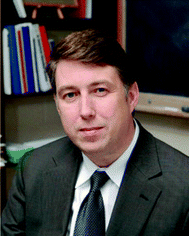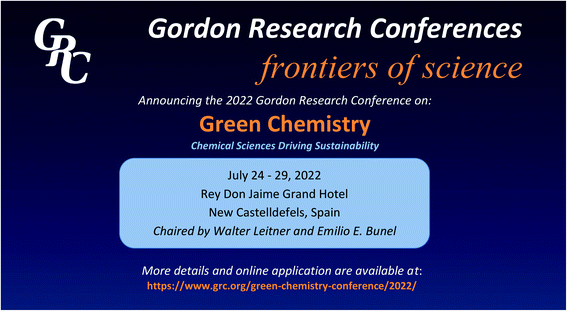If sustainability is the goal, green chemistry will show the way! – happy birthday to Paul Anastas
Walter
Leitner
 ab
ab
aMax Planck Institute for Chemical Energy Conversion, Stiftstr. 34-36, 45470 Mülheim an der Ruhr, Germany. E-mail: walter.leitner@cec.mpg.de
bInstitut für Technische und Makromolekulare Chemie, RWTH Aachen University, Worringerweg 2, 5274 Aachen, Germany
On May 16 1962, Paul T. Anastas was born in the city of Quincy, Massachusetts, on the east coast of the USA. It may seem obvious that the person who is referred to in Wikipedia as “Father of Green Chemistry” deserves on the occasion of his 60th birthday a special address in the journal dedicated to exactly this field. There is, however, significantly more to justify the writing of this Editorial than that single criterion.
Excellence in science – In his outstanding scientific career, Paul has sought not merely to understand environmental issues from an academic perspective but rather to address them through innovation and progress in the molecular and engineering sciences. His discoveries related to new chemical and process design successfully demonstrated the green chemistry principles that he formulated with John Warner as the basis of the field. There is not the space here to discuss in detail his many ground-breaking contributions in areas as important and competitive as molecular design for reduced hazards, avoidance of persistent pollutants, renewable energy storage, selective transformation of bio-based feedstocks, and capture and utilization of CO2. His original work and the many highly influential reviews and perspective articles are readily retrieved from bibliographic services. It may suffice here to highlight the inspiring discussion of the “Green ChemisTREE” presented by Paul and his team in this journal.2
Entrepreneurial endeavours – While the science of the Anastas Lab has resulted in high impact, well-cited publications, it has also become the basis of patents and several spin-off activities and companies. Examples include the development of earth-abundant metal catalysts for water splitting even in seawater, that form the innovation basis of Catalytic Innovations LLC. Efforts on the selective transformation of biomass have led to the foundation of P2 Science, a thriving multimillion dollar enterprise producing flavours and fragrances from bio-based raw materials supplying ingredients to companies such as Chanel, L'Oréal, and Estée Lauder. The pragmatic approach of Paul to tech transfer is also reflected in the commercialization of a catalyst and process for converting CO2 into impurity-free alcohols via the launch of Air Co., a technology, engineering, and design company, co-founded by Stafford Sheehan, a former student in the Anastas lab.
Community building and leadership – What is so special about Paul is the fact that his contributions do not end with science and technology. The field of green chemistry as we know it today would not be what it is without 30 years of tireless effort from Paul. He founded the first green chemistry research funding program at EPA back in 1991, founded the first national green chemistry conference in 1996 (which he chaired for 10 years), launched the Presidential Green Chemistry Award in 1995, and co-founded the Green Chemistry Institute of the American Chemical Society in 1997. Paul served in the White House Office of Science and Technology Policy of the US Government from 1999 to 2004. He acts on Editorial and Advisory Boards for scientific journals in the field including for this periodical since 2013. However, whenever you hear Paul speaking about the incredible successful development of the field of green chemistry, he will describe it as the result of the community reflecting the contributions of many. But the truth is that any team needs a captain and any pack needs a leader – someone just like Paul.
Communication and inspiration – In 1998, a compact compendium entitled “Green Chemistry: Theory and Practice” appeared on the market for books in molecular sciences.3 It was certainly unusual in various ways. Unlike the typical edited volumes on emerging topics, it did not comprise a collection of multi-author contributions, but had been written by only two fellow scientists: Paul T. Anastas and John C. Warner. Unlike a typical chemistry textbook, it was not structured according to reaction mechanisms or synthetic methods, but presented a set of twelve principles as an intellectual framework to plan a research agenda. And unlike many technical reports, it proved valuable not only to those skilled in the art, but also profoundly changed the perception of chemistry in society. His latest book “The Periodic Table of the Elements of Green and Sustainable Chemistry”4 – written together with Julie B. Zimmerman – continues this tradition of mastering complexity through a well-structured perspective that is accessible to a broad audience. I had the pleasure of experiencing this inspirational approach as part of an author group with Paul, Julie Zimmerman and Hanno Erythropel for a recent perspective article.5 Needless to say that Paul has proven his ability to raise awareness and enthusiasm simultaneously in zillions of intellectual and yet entertaining lectures around the world, addressing very distinct target groups from students, fellow scientists, industrial decision makers, to politicians.
The reader of this Editorial will hardly be surprised that Paul has obtained numerous distinctions and awards around the world. He holds three honorary doctorates (Queens University, Northern Ireland; McGill University, Canada; and the University of Massachusetts, USA). He has received the Wöhler Award for sustainable chemistry from the German Chemical Society, the UK's Royal Society of Chemistry Green Chemistry Award, the Italian Chemistry Society's Silver Seal Medal, and the King Carl XVI Gustaf Professorship in Environmental Science from Sweden. The 2021 Volvo Environment Prize is the most recent, but surely not the last highly prestigious recognition of his scientific contributions improving the state of the world's environment.
What may be surprising, however, is that with all of these achievements and recognition, Paul is the most humble, friendly, and charming person that you will probably ever meet. A conversation with him can be intellectually captivating and yet irresistibly humorous at the same time. And although I know how quickly he feels embarrassed when he thinks someone makes a fuss about him, I am convinced that he will forgive me in this case because I use this Editorial only as a proxy for the whole green chemistry community sending him a warm “Happy birthday, Paul”.
P. S. If you are looking for a chance to meet Paul in person, there is an opportunity this summer at the GRC Green Chemistry: https://www.grc.org/green-chemistry-conference/2022/
Notes and references
- P. T. Anastas, B. Han, W. Leitner and M. Poliakoff, “Happy silver anniversary”: Green Chemistry at 25, Green Chem., 2016, 18, 12–13 RSC.
- H. C. Erythropel, et al., The Green ChemisTREE: 20 years after taking root with the 12 principles, Green Chem., 2018, 20, 1929–1961 RSC.
- P. T. Anastas and J. C. Warner, Green Chemistry: Theory and Practice, Oxford University Press, 1998, ISBN 0198502346 Search PubMed.
- P. T. Anastas and J. B. Zimmerman, The Periodic Table of the Elements of Green and Sustainable Chemistry, Bookbaby, 2020, ISBN 9781734546309 Search PubMed.
- J. B. Zimmerman, P. T. Anastas, H. C. Erythropel and W. Leitner, Designing for a green chemistry future, Science, 2020, 367, 397–400 CrossRef CAS PubMed.
| This journal is © The Royal Society of Chemistry 2022 |


